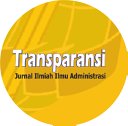Evaluasi Implementasi Prepopulated Error System Pada Aplikasi Efaktur 3.0
DOI:
https://doi.org/10.31334/transparansi.v5i2.2624Keywords:
Policy Implementation, VAT Administration, Tax-Invoice Technology,Abstract
The modernization program gave by the Directorate General of Taxes (DGT) in further developing the assistance nature of PKP citizens in the tax assessment area through guiding the pre-populated 3.0 e-faktur application is thought of as viable and adequate to citizens. The consequences of past investigations discovered that steering this application can lessen contributing mistakes on input charge solicitations physically, make it simpler to report VAT period expense forms, to work on the nature of administrations did by the Directorate General of Taxes. Be that as it may, with the expanding nature of administration for citizens, steering this application additionally needs to assess the issues and requirements experienced by citizens in showing and working this application to taking a stock of pre-populated VAT Tax Returns (SPT) issues and approving Import Notifications of Goods ( PIB). Does this application framework actually must be updated in running and working it (Error System), and what are the answers for manage issues and hindrances in case of a framework mistake that is frequently capable by citizens in working this application. The motivation behind this study is to make it simpler for citizens to deal with issues and impediments in the blunder framework application, assess the execution of pre-populated VAT returns subsequent to running the pre-populated e-receipt 3.0 application. This examination strategy utilizes subjective techniques with information assortment cycles and specialized information investigation. Information examination information sources are acquired from information assortment through e-research, subjective methodologies through meetings and perceptions. The aftereffects of the discoveries of this study are relied upon to give direction on the straightforwardness and perfection of the Directorate General of Taxes (DGT) in expanding the utilization of this pre-populated e-receipt 3.0. It is likewise an extra knowledge into data for scientists, instructors/speakers and citizens. Turn into a reference and extra data for the Directorate General of Taxes in working on the nature of assessment administrations, as well just like a wellspring of guidance and contribution for strategy producers. Subsequently, the creator raises research on e-invoicing applications that frequently experience framework blunders in their activities.References
G. Gunawan, “Determinan Kesuksesan Implementasi Aplikasi e-Faktur,†Seiko J. Manag. Bus., vol. 4, no. 1, pp. 84–97, 2021.
R. Kusyeni and R. Nugraha, “Implementasi Prepopulated Pajak Masukan dan SPT Masa PPN,†vol. 8, no. 2, pp. 172–182, 2021.
D. A. Safitra, “Implementasi E-Tax Invoice : Sebuah Studi Komparatif,†J. Pajak Indones., vol. 2, no. 1, pp. 95–105, 2019.
L. Christin, “Pengaruh Penerapan e-Faktur dan e-SPT PPN Terhadap Kepatuhan Perpajakan Pengusaha Kena Pajak Dengan Kemampuan Menggunakan Internet Sebagai Variabel Moderating,†Media Akunt. Perpajak., vol. 2, no. 1, pp. 35–44, 2017, [Online]. Available: http://journal.uta45jakarta.ac.id/index.php/MAP/article/view/879
A. Penerapan and E. P. Dan, “E-Faktur Web Based ( Studi Kasus Pada Pt Mitra Buana Koorporindo ),†vol. 1, no. 3, pp. 199–212, 2021.
J. Akuntansi and U. S. Ratulangi, “Evaluasi Penerapan Sistem Efaktur 3.0 Dalam Pelaporan SPT PPN,†vol. 16, no. 2, pp. 157–168, 2021.
V. Anwar, A. R. Mus, and M. Mursalim, “Dampak Penerapan e-Faktur dan Efisiensi Pengisian SPT Terhadap Motivasi Memenuhi Kewajiban Perpajakan,†vol. 3, no. 2, pp. 166–179, 2020.
A. B. Firdaus and A. Marfiana, “Penerapan pre populated data PM pada aplikasi e-faktur dan kesesuainnya dengan peraturan PPN,†vol. 1, no. 3, pp. 219–229, 2021.
O. Covid, “and the Food and Agriculture Sector: Issues and Policy Responses.†OECD: Paris, France, 2020.
D. Yustisia, “Menilik Gagasan Pre-Populated Tax Return,†DDTC, 2018.
N. Lutfiyana, A. K. Junior, D. Daryanto, P. D. Purba, O. O. Simbolon, and V. Rahmayanti, “Audit Sistem Informasi Aplikasi Scan Barcode E-Faktur Pajak Menggunakan Cobit Framework 5.0 Domain DSS pada PT. Japan Asia Consultants,†J. Inform. dan Rekayasa Perangkat Lunak, vol. 2, no. 2, p. 161, 2020, doi: 10.36499/jinrpl.v2i2.3497.
Direktorat Jenderal Pajak, KEP-136/PJ/2014 Penetapan PKP yang diwajibkan membuat FP berbentuk elektronik. 2014.
Kementerian Keuangan RI, PER-24/PJ/2012 Dalam, Pemberitahuan Pembuatan, Rangka Cara, Tata Atau, Pembetulan Tata, D A N Pembatalan, Cara Pajak, Faktur Cara, Tata. 2012.
Peraturan Kementerian Keuangan, “PMK No. 151/PMK.011/2013 Tata Cara Pembuatan & Pembetulan atau Penggantian Faktur Pajak,†vol. 2009, 2013.
A. E. Naconha, “disimiliritas efaktur 3.0,†vol. 4, no. 1, p. 6, 2021.
et. al. Tambun, Sihar, “Pengaruh Technology Acceptance Model Dan Digital taxation Terhadap Kepatuhan Wajib Pajak Dengan Pemahaman Internet Sebagai Variabel Moderatingâ€.
N. Alfisyah, “Faktor-Faktor yang Mempengaruhi Wajib Pajak dalam Menggunakan Sistem e-Filling,†2020.
E. et. el. Usanto, “Pengaruh Persepsi Penggunaan Technology Acceptance Model (TAM) terhadap Penggunaaan E-Filling,†Akunt. Perad., vol. 5, no. 1 Juni 2019, 2019.
Noeng Muhadjir, “Metodologi Penelitian Noeng Muhajir,†2019.
L. J. Moleong, Metodologi penelitian kualitatif. PT Remaja Rosdakarya, 2021.
P. D. Sugiyono, “Metode Penelitian Bisnis: Pendekatan Kuantitatif, Kualitatif, Kombinasi, dan R&D,†Penerbit CV. Alf. Bandung, 2017.
C. John and Creswell David, “Research design : qualitative, quantitative, and mixed methods approaches,†e-Pedagogium, vol. 16, no. 4, p. 275, 2018, [Online]. Available: https://www.ebooks.com/95887090/research-design/creswell-john-w-creswell-j-david/?fc=MY&src=feed&gclid=CjwKCAjwj4zaBRABEiwA0xwsP4U5JGmf9boYzchbEiJksnD48-R_5aCetJQB5s36Qzf3CZwX0AHY-BoCZlcQAvD_BwE
M. A. Zakariah, V. Afriani, and K. H. M. Zakariah, Metodologi Penelitian Kualitatif, Kuantitatif, Action Research, Research and Development (R n D). Yayasan Pondok Pesantren Al Mawaddah Warrahmah Kolaka, 2020.
R. Affrian, “Kebijakan Publik by Eko Handoyo ( z-lib . org ),†Semarang: Widya Karya, p. 323, 2012.
M. M. Mark, G. T. Henry, and G. Julnes, “Evaluation: An Integrated Framework for Understanding, Guiding, and Improving Policies and Programs,†2000.
Rusmini, “Aplikasi Dan Evaluasi Kebijakan ( Analisis Kebijakan Walikota Jambi Tentang Penghapusan Pungutan Sekolah Dari Masyarakat),†Annu. Conf. Islam Educ. Manag., pp. 854–861, 2018.
V. L. P. C. Jhon W. Creswell, Designing and Conducting Mixed Methods Research. 20189.
William N Dunn, Public Policy Analis, vol. 1999, no. Agustus. 2017. doi: file:///C:/Users/Hello/Downloads/Public Policy Analis W. Dunn.pdf.
M. Peluang, “K o n s i s t e n 2020 1,†2020.
P. S. Akuntansi, “Faktor-Faktor yang Mempengaruhi Wajib Pajak yalam Menggunakan Sistem E-Filling,†vol. 01, pp. 59–68, 2020.
F. Adziem, A. Akhmad, M. Nuhung, and M. Jannah, “Peranan Prepopulated Data Dalam Meningkatkan Kemudahan Pelaporan Pajak Pertambahan Nilai Pada Kantor Pelayanan Pajak (Kpp) Pratama Makassar Utara,†Amnesty J. Ris. Perpajak., vol. 4, no. 2, pp. 413–420, 2021, doi: 10.26618/jrp.v4i2.6335.
https://ortax.org/cara-mengatasi-kode-error-pada-efaktur-3-1
https://pajak.go.id/id/prepopulated-pajak-masukan-dan-spt-masa-ppn-pada-aplikasi-e-faktur
https://www.academia.edu/44229045/Prepopulated_Pajak_Masukan_dan_SPT_Masa_di_Aplikasi_Efaktur_3_0
https://www.online-pajak.com/tips-ppn-efaktur/masalah-e-filing-ppn
Downloads
Additional Files
Published
Issue
Section
License

This work is licensed under a Creative Commons Attribution-ShareAlike 4.0 International License
Please find the rights and licenses in Transparansi : Jurnal Ilmiah Ilmu Administrasi By submitting the article/manuscript of the article, the author(s) agree with this policy. No specific document sign-off is required.
- License
The commercial use of the article will be governed by the Creative Commons Attribution license as currently displayed on Creative Commons Attribution-ShareAlike 4.0 International License.
2. Author(s)' Warranties
The author warrants that the article is original, written by stated author(s), has not been published before, contains no unlawful statements, does not infringe the rights of others, is subject to copyright that is vested exclusively in the author and free of any third party rights, and that any necessary written permissions to quote from other sources have been obtained by the author(s).
3. User Rights
Transparansi : Jurnal Ilmiah Ilmu Administrasi spirit is to disseminate articles published are as free as possible. Under the Creative Commons license, Transparansi : Jurnal Ilmiah Ilmu Administrasi permits users to copy, distribute, display, and perform the work for non-commercial purposes only. Users will also need to attribute authors and Transparansi : Jurnal Ilmiah Ilmu Administrasi on distributing works in the journal and other media of publications.
4. Co-Authorship
If the article was jointly prepared by more than one author, any authors submitting the manuscript warrants that he/she has been authorized by all co-authors to be agreed on this copyright and license notice (agreement) on their behalf, and agrees to inform his/her co-authors of the terms of this policy. Transparansi : Jurnal Ilmiah Ilmu Administrasi will not be held liable for anything that may arise due to the author(s) internal dispute. Transparansi : Jurnal Ilmiah Ilmu Administrasi will only communicate with the corresponding author.
5. Miscellaneous
Transparansi : Jurnal Ilmiah Ilmu Administrasi will publish the article (or have it published) in the journal if the article’s editorial process is successfully completed. Transparansi : Jurnal Ilmiah Ilmu Administrasi editors may modify the article to a style of punctuation, spelling, capitalization, referencing and usage that deems appropriate. The author acknowledges that the article may be published so that it will be publicly accessible and such access will be free of charge for the readers as mentioned in point 3.
Every accepted manuscript should be accompanied by "Copyright Transfer Agreement"prior to the article publication.











